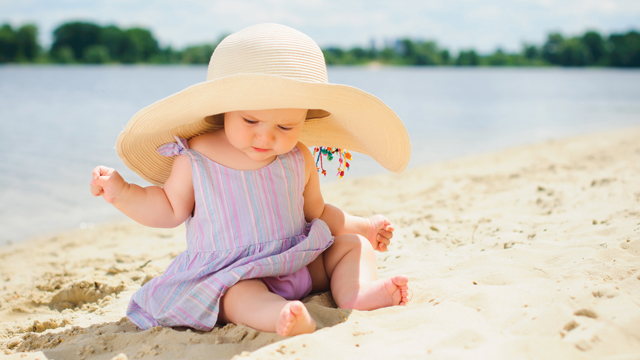Teaching your kids the value of sunscreen from day one and make sun safety part of your family wellness ritual.
Now that spring is morphing into summer and the weather is consistently warmer, you’ll want to take your family outside to places like Maymont, Lewis Ginter Botanical Garden, City Stadium for a Kickers game, or The Diamond to see the Flying Squirrels in action.
With all these great activities on the horizon, now is the perfect time to review sun safety for kids!
Sun exposure can cause sunburns, skin damage, and skin cancer. It is important to remember that most damage from the sun occurs during childhood and all ethnicities and skin types need protection. Children with dark skin, or skin that tends to tan rather than burn, are also at risk for the health complications that come with too much sun exposure.
Whether you’re on a short neighborhood walk with your kids or planning a day at the beach, always consider your children’s exposure to the sun. Even on cloudy days, the sun’s rays affect us.
Do your best to keep infants out of direct sunlight and in the shade. There are multiple ways to avoid the sun’s harmful rays, including sun hats, tents, and umbrellas. Try to keep extra hats and sunglasses for the kids with you at all times. As early as possible, begin the process of helping your baby get used to the idea of wearing a hat and those adorable baby sunglasses that aren’t just for show. Clothing that is tightly woven or labeled as sun protective can help, too. When avoiding direct sunlight, remember that the sun’s rays are the strongest between ten in the morning and four in the afternoon.
Sunscreen Safety for Babies
Parents often ask the pediatrician about sunscreen and at what age they should start applying it to their infants. According to the American Academy of Pediatrics, infants six months and older should use a sunscreen of sun protection factor (SPF) fifteen or higher on all exposed skin. However, even the littlest ones under six months can use a very minimal amount of sunscreen on exposed areas if sun coverage is not available. I encourage families to use sun-protective clothing. Even with these safeguards, I would keep direct sun exposure at a minimum for infants younger than six months.
There are many sunscreen options out there for families. When choosing a sunscreen, remember to look at the ingredients, check the SPF, and make sure it is broad spectrum. A sunscreen’s active ingredients will either filter or physically block the harmful UVA/UVB rays. For children, it is important to choose a sunscreen that is at least SPF fifteen. Zinc oxide is an active ingredient that protects against both UVA and UVB rays.
Make sure to apply sunscreen to the whole body and be careful to avoid the eyes. When applying sunscreen to your child, test a small area first for sensitivity. If a rash develops, stop using the product and call your pediatrician. Be sure to note the ingredients that caused a reaction so you can make a different choice next time. If you have more than one child, there’s a chance a brand that works for one child might not be a good fit for another. Keep testing!
Sunscreen comes in many forms including sprays, lotions, and sticks. If given the option, we recommend lotion over sprays so you can quantify how much sunscreen is applied to your children. The general guideline for application of lotion is about an ounce of sunscreen – about a palmful – every two hours or after water exposure. Remember to apply sunscreen thirty minutes prior to being outside in the sun. If using a sunscreen spray, be sure to use your hands to apply the sunscreen to face, cheeks, and ears. The FDA also warns against using spray sunscreen near an open flame. Many families prefer sunscreen sticks for sensitive areas like noses and ears.
Even with the best sun safety practices, your child may still get sunburned. With a mild sunburn, you can apply cool compresses or aloe gel to the affected area and give acetaminophen or ibuprofen as needed for pain. If blisters or fever occur, call your pediatrician.
Just as it’s a good idea to train your infant to not pull off his wide-brimmed hat on sunny days, it’s smart to introduce applying sunscreen to the daily family ritual. If all goes well, your 5-year-old might be putting on sunscreen automatically every day at home before venturing outside. Practicing sun safety with your children and helping them establish good habits sets them up for a healthy lifestyle.





